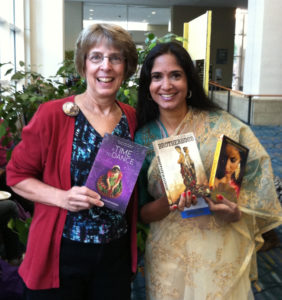 How’s this for serendipity? When I met conference keynoter Padma Venkatraman at the James River Writers conference in October 2016, she recognized my book. She’d read it! Turns out her book had also received the NCSS Notable Trade Book Award. We were award-sisters! And right then, I knew I had to interview Padma for my blog.
How’s this for serendipity? When I met conference keynoter Padma Venkatraman at the James River Writers conference in October 2016, she recognized my book. She’d read it! Turns out her book had also received the NCSS Notable Trade Book Award. We were award-sisters! And right then, I knew I had to interview Padma for my blog.
I’ve just read her multiple-award-winning novel A Time to Dance about a girl who dreams of dancing again after losing a leg in a bus accident. It’s intense, at times funny and sad, soul-touching, heart-warming—all in all, a great read.
A.B. Westrick: Welcome, Padma!
Padma Venkatrama: Hello! Thanks for having me.
ABW: Your keynote address was inspirational, and I’d love for you to repeat a bit of what I heard you say at the James River Writers conference. Would you please talk about “going method”—the way you approached the task of writing about a character who’d lost a leg? It was so interesting. What did you do, and how did it influence your writing process?
PV: I’d like to begin by sharing with your readers the incident that inspired A Time to Dance. On a trip to India in my late teens, I was bitten by a viper, one of the most poisonous Indian snakes.
ABW: Oh, no!
PV: Oh, yes! It’s a miracle I survived without having to have my leg amputated. That experience—of nearly losing life and limb—solidified my sense of spirituality (which isn’t necessarily bound to any religion).
Much later (I won’t say quite how many years later, but I’m definitely not in my teens any more)—I felt I heard a character’s voice in my head and then my mind and heart were possessed by her and her story. In some ways, that character—Veda, the protagonist of A Time to Dance—is like me; in some ways she isn’t.
(Whenever any writer writes about a character who isn’t entirely like the writer, it’s a challenge. But if all we did was to write about characters like us, we’d all be memoirists! And, frankly, even if we write memoirs, we’re usually writing about who we once were, not who we now are…)
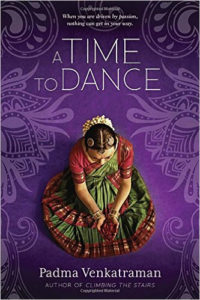 So I knew I had to write Veda’s story, but I had to do my research with utmost respect. I took over 5 years to complete the novel because I wanted to try my hardest to be accurate and true to Veda’s experience of disability in India. In addition to reading extensively and interviewing many doctors, nurses, medical professionals, prosthetists, dancers, and, most importantly, people with disabilities, I also “went method” the way an actor might.
So I knew I had to write Veda’s story, but I had to do my research with utmost respect. I took over 5 years to complete the novel because I wanted to try my hardest to be accurate and true to Veda’s experience of disability in India. In addition to reading extensively and interviewing many doctors, nurses, medical professionals, prosthetists, dancers, and, most importantly, people with disabilities, I also “went method” the way an actor might.
I used crutches and experimented on myself to simulate phantom sensation. I bound up my leg and tried dance moves. I even drank a lot of water one night and then went to bed with my leg bound, to experience the feeling of waking up at night and not having my crutches right next to me.
ABW: This is what I recall you saying at the conference. You went all-out to try to experience your character’s struggle.
PV: Yes, but even so, I felt like I had permission to write the book only when a reader, who had the same disability as Veda does, was moved to tears by a draft I’d asked her to read and expressed her amazement that although I do not have that disability, I “knew exactly how phantom pain” felt.
This, by the way, doesn’t mean I do actually know this. It just means I felt I had her blessing—and then the blessings of about 10 – 15 other beta readers who had the same disability. Despite what I might have done to gain understanding and empathy, I only caught a glimpse of what it is like for people with disabilities to live in a world that privileges people without disabilities. No more than a glimpse.
ABW: Your writing comes across as authentic, and I applaud you for your patience and willingness to seek out multiple beta readers. I have to tell you that I find it encouraging that it took you 5 years to write the book—encouraging because my next novel is taking me longer than I anticipated it would!
But back to A Time to Dance: I particularly enjoyed the secondary characters. From the grandmother to the American prosthetics engineer, they were richly drawn and your protagonist’s relationships with them felt real. How did you go about crafting these characters? To what extent are they based on people you’ve known? How much is pure fiction?
PV: I’ve always been impressed by American volunteers who travel in droves to other nations to do their best to help. Jim’s character was partly inspired by someone I met while doing research for the novel. But although I did incorporate Jim, I made sure his role was small—the last thing I wanted was for him to be Veda’s white saviour. We have far too many of those. So he shows up, helps, and then leaves. He’s truly secondary.
The others are more important secondary characters: Veda’s love interest, her best friend, her parents and grandmother, her teachers. Many of them are based on people I know. But then, as with all fiction, while the starting point might be rooted in the truth, by the time the character grows, the truth is a mere kernel. It’s like watching a tree branch out and blossom; by the time it bears fruit, it no longer is anything like the seed it once was.
 ABW: Yes, a good analogy. Now I have a question about a comment you made in your Acknowledgments: you thanked your editor for encouraging you to experiment with the novel’s form. A Time to Dance is in verse, and your earlier novels, Climbing the Stairs and Island’s End, are written in prose. How did writing in verse make this story better than it might have been as prose? What are some pros and cons to writing a novel in verse vs. prose?
ABW: Yes, a good analogy. Now I have a question about a comment you made in your Acknowledgments: you thanked your editor for encouraging you to experiment with the novel’s form. A Time to Dance is in verse, and your earlier novels, Climbing the Stairs and Island’s End, are written in prose. How did writing in verse make this story better than it might have been as prose? What are some pros and cons to writing a novel in verse vs. prose?
PV: When Veda’s character possessed me, I heard verse. But I fought against writing A Time to Dance in verse because although I love and read poetry, I hadn’t studied it. Luckily for me, Richard Blanco (who later read at President Obama’s inauguration) let me sit in on a poetry workshop he was doing at the University of Rhode Island’s Ocean State Summer Writing Conference, and his friendship and faith in my ability helped me overcome my fear of experimenting with this form. Other wonderful poets also encouraged me, including Peter Covino, Mary Capello, Scott Hightower, Jody Lisberger, and Kristin Prevallet, as did my marvelous agent Rob Weisbach and my star editor Nancy Paulsen. I’m deeply grateful for her unwavering support, understanding, and patience as the novel evolved.
Another editor whom I deeply trust, Stephen Roxburgh, provided insights that were vital. He’s edited many books I admire and love—everything from Marilyn Nelson’s Newberry-winning Carver: A Life in Poems to Roald Dahl’s The B. F. G to Carolyn Coman‘s works—and it meant so much to me that he read and provided feedback on my work. He helped me see that Veda’s core story is one of spiritual growth. And spiritual growth occurs in wordlessness, which verse requires—it’s in that white space between words. I commented on this in a recent blogpost.
ABW: Ahhh, I’ve just read your post. Very thoughtful.
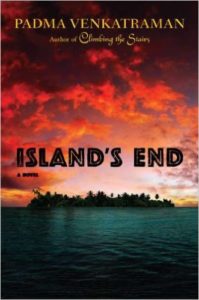 PV: I enjoyed writing that piece. And I would also say that with this story, rather than form affecting content, it was the other way around: Veda’s voice and content dictated form. It was really a tremendous relief that A Time to Dance was released to starred reviews in 5 major journals, and that it’s been so glowingly reviewed by so very many other sources.
PV: I enjoyed writing that piece. And I would also say that with this story, rather than form affecting content, it was the other way around: Veda’s voice and content dictated form. It was really a tremendous relief that A Time to Dance was released to starred reviews in 5 major journals, and that it’s been so glowingly reviewed by so very many other sources.
ABW: That reinforces the craft advice to listen closely to your characters. Do you plan to write your next novel in verse—do you hear it in verse—or are you returning to prose? And what are you working on now?
PV: I’m delighted to say that Penguin recently signed up my latest novel, which should, if all goes well, be released in 2019.
ABW: Congratulations! Great news.
PV: Thank you. It’s about children living on their own and eking out a living on the streets of an Indian city. And yes, this one is in prose—but I hope I’ll live long enough to write other novels in verse. I do love that form, as well.
ABW: I look forward to reading it!
Now let me ask about your website. The tag line there is: “Stories are ships on which we sail oceans of imagination.” Why this particular tag line? What special significance does it have for you?
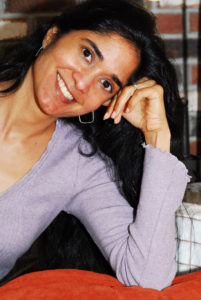 PV: Growing up in the Indian culture, it was tremendously important to me to be financially independent. I couldn’t see myself living the way I wished if I pursued a career in the arts, so I became an oceanographer (I always loved science and mathematics, just as I loved words). But eventually, I felt secure enough to risk a foray into the field of literature, which, thankfully, was successful. And I think that tag line brings together my worlds of oceanography and story, of science/mathematics and language.
PV: Growing up in the Indian culture, it was tremendously important to me to be financially independent. I couldn’t see myself living the way I wished if I pursued a career in the arts, so I became an oceanographer (I always loved science and mathematics, just as I loved words). But eventually, I felt secure enough to risk a foray into the field of literature, which, thankfully, was successful. And I think that tag line brings together my worlds of oceanography and story, of science/mathematics and language.
Which are and aren’t that different. Music is mathematics given voice; language at its best sings. Writing is about word patterns; mathematics is about number patterns. And the oceans of our imagination are sailed, in different ways, but equally well, by scientists and story-tellers.
ABW: I love hearing you reflect on music, mathematics, and oceans this way. My oldest daughter teaches college-level math and has described her research as “more art than numbers.” I get it. And I love your comment that language at its best sings.
One more question! Can you tell us sometimes-language-challenged Americans how to pronounce your last name?! (Which syllable gets the accent?)
PV: My first name is actually Padmavathi, not Padma! So that’s pretty long, but I hardly ever use the full form, unfortunately (it sounds rather lovely). There’s a link on how to pronounce my name right on my website’s resources page! There’s no accent, which is what trips up some Americans. All syllables have equal weight and length. And, hey, not all of us Americans are language-challenged…
ABW: Hahaha. True that. I just checked out your Resources page and practiced saying your name, and you’re exactly right that the lack of an accent was the thing that tripped me up!
Thank you so much for doing this blog interview. I’m just thrilled that we had a chance to chat at the James River Writers conference, and I look forward to reading all of your books.
PV: Thanks so much, Anne. It’s an honor and a pleasure to be interviewed by you!
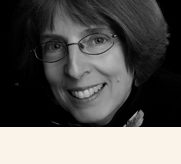
Great Q&A. Adore both of you!
Thank you, Robin. I’d wanted to hear your conference panel with Padma, but I was speaking on a different panel at the same time. Ahhh… such is the way of things at writers conferences!
Great interview, Anne and Padma! I was fortunate to be on a panel as well with Padma at NCTE, and appreciated hearing the story of A Time to Dance as well as Climbing the Stairs and Island’s End. Looking forward to the next book!
Lyn, I love hearing that you connected with Padma at NCTE. Her blog post about “white space and spirituality” (http://padmasbooks.blogspot.com/2015/11/words-white-space-and-spirituality.html) is the one she wrote after the NCTE conference.